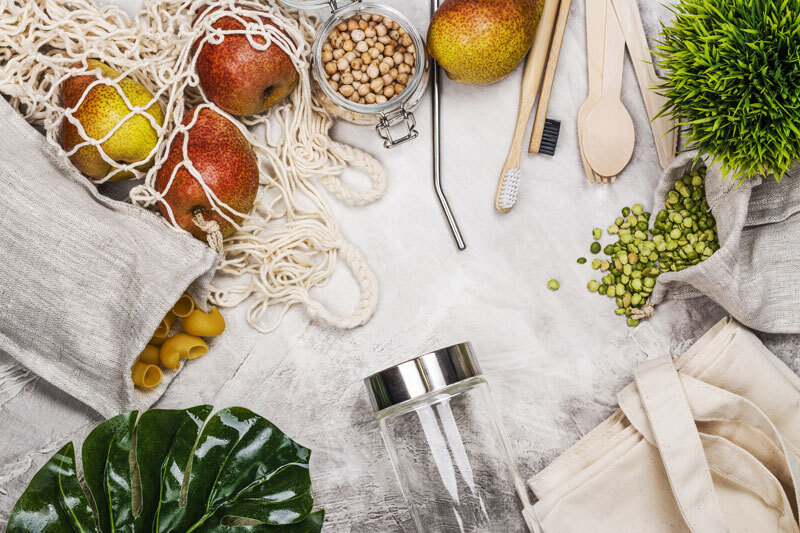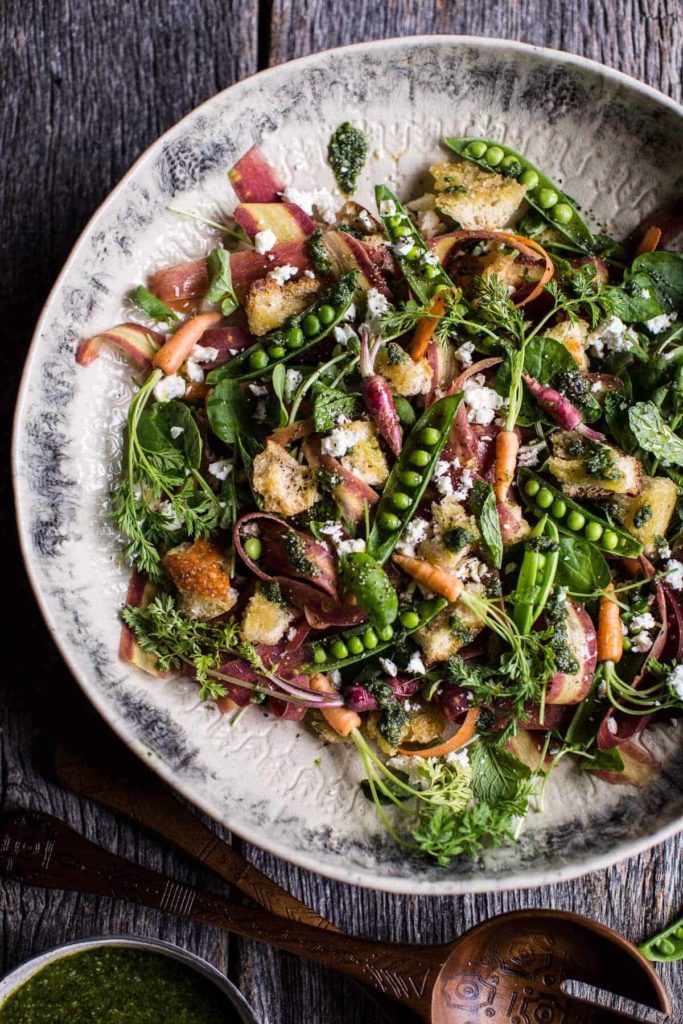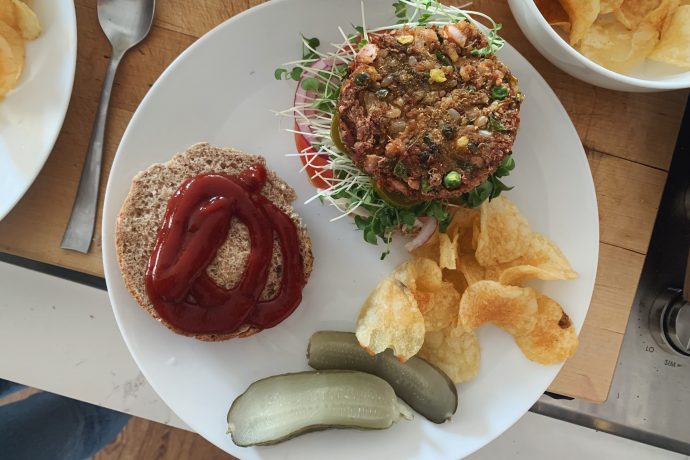Every day the average American wastes 1 lb of food! When we throw out food, we not only waste the food itself but also abuse all of the resources that went into getting the food on our plates in the first place: water, labor, and energy it takes to grow, process, and transport it.
Globally, we waste 30 percent of food grown every single year—accounting for 8% of total greenhouse gas emissions. Reducing food waste is number three on the list of 100 solutions to reduce global carbon gas emissions by 2050.
If you are looking for ways to reduce your carbon footprint while supporting a healthier planet, and saving money, getting creative in the kitchen is a great place to start. In this article, we’re sharing how you can begin a zero waste lifestyle with our favorite zero waste recipe ideas.
TRUTH BOMB:
You’re
Already killing it!
If You Were More Consistent With Your Wellness Routine, You’d Be Unstoppable.
Before we start, it’s important to note that going completely zero waste isn’t possible for everyone. Zero waste grocery stores, farmers’ markets, and fresh produce without plastic can be hard to find. Taking it one step at a time and doing what you can is perfect in itself.
Zero Waste Must-Haves
Grocery Shopping
When possible, shop at your local farmers’ market or bulk food store. Here are key ingredients for a zero-waste kitchen:
What to Buy?
- Fresh vegetables
- Fresh fruits
- Fresh herbs
- Legumes
- Nuts and seeds
- Grains
- Rice
- Pasta
- Pastured dairy and eggs
- Dry herbs and spices
- Dried fruit
- Baking supplies
- Coffee and tea
- Cloth bags
- Reusable produce bags
- Jars and containers
Zero Waste Recipe Tips
- Buy seasonal whenever possible. This reduces the carbon footprint caused by our extensive supply chain.
- Buy local. Buying local helps your community. Local food travels fewer miles to get to you, which means it is better for you (higher nutrient content) and better for the planet.
- Buy organic when possible. Organic often costs more but it benefits your health and the health of the farmers by reducing their exposure to pesticides. And it’s way better for the earth and soil.
- Buy produce that you can extend the season on. For example, you can roast and freeze tomatoes, make tomato paste or sauce, and freeze, ferment tomatoes, dehydrate tomatoes, and can tomatoes. You can also make yummy preserves, jams, jellies, and even cleaning products.
If you don’t have access to a farmers market or bulk store, here are some tips to help reduce plastic waste:
- When shopping, bring produce bags, jars/containers, and cloth shopping bags. Refuse plastic bags or reuse them over and over again in your home
- Forego the plastic produce bags: most items don’t need a produce bag like bananas and onions
- Consider joining a CSA (community supported agriculture) and request no plastic
- Buy giant packages of food like rice, flour, and beans
- Split big packages of food with friends and neighbors (this will also help you save money!)
- Consider starting your own garden at home!
Food Scrap Recipe Ideas
Roast cauliflower leaves
- Sprinkle with olive oil, salt, pepper, and roast leaves in the oven
- Sometimes you can get these leaves for free from vendor’s at the farmers’ market
Save Bean Broth
- Receive bean broth for soup or dal
Regrow it
- Regrow your green onions, celery roots, basil
Keep spent coffee grounds
- Spent coffee grounds are edible, and you can add them to brownies, toss them in your garden soil!
Tye Dye Old Clothes
- Use veggie scraps like red onion peels and avocado pits for beautiful and all-natural tye-dye coloring
Dehydrate nut and seed milk pulp
- Add dried nut milk pulp to a food processor and use immediately or store it in the freezer. Add some to pancakes, cookies, and bread.
Make a stock/broth
Vegetable options:
- Asparagus woody ends
- Bell pepper bits
- Garlic bits and shells
- Onion and shallot trimmings and their skins, in moderation
- Cucumber skins
- Celery bits and leaves
- Potato skins and scrap s
- Leek greens and white ends
- Mushroom stems
- Carrot ends and shavings
Directions: freeze everything until you have enough scraps to make a batch of broth. Have them somewhat thawed out.
Healthy Zero Waste Recipes Ideas
Marcella Beans with Sausage and Beet Greens
Often, people throw out the green top of the beets, but after trying this recipe, you’ll love these greens just as much as kale or chard. Mix them with sausage and beans for a yummy dinner or even just stir fry them with onions and garlic for a delicious and simple side.
Baked Carrot and Coconut Fritters
If you juice in the morning, forget about tossing the veggie pulp. Veggie pulp has all of that leftover fiber and nutrients and it should never go to waste. This recipe from Mari Jasmine is drool-worthy. Turn your breakfast leftovers into dinner with these savory fritters.
Charred cumin, smoked paprika, and lemon cauliflower with roasted chickpeas and tahini yogurt dressing
This recipe from Women’s Health Magazine uses dried chickpeas, fresh herbs, and spices for a delicious side. Not only is this recipe easy to make, it will also save money and slash your carbon footprint.
Broccoli Stem Noodles with Ginger-Sesame Dressing
Get your spiralizer out, this recipe from All Day I Dream About Food is ridiculously easy. If you throw out your broccoli stems, stop it now! This low-carb meal with yummy Asian-inspired vibes might just be your new favorite zero-waste lunch.
Velvety Mushroom Soup
Shiitake mushrooms are incredible for immunity and whole health. Next time you make some shiitake bacon, save the stems! Shiitake stems have a rough and woody texture, but like most stems, they will make a delicious broth. This recipe from Food52 is the perfect way to reduce waste and nourish your body.
Spring Pea and Carrot Salad with Carrot Top Pesto
Waste no food with this spring salad from Half Baked Harvest. Instead of throwing out carrot greens, you’ll turn them into a delicious pesto. This salad is perfect for lunch or even hearty enough for dinner.
Preserved Lemons
Preserved lemons are fabulous and especially if you want to treat yourself with limoncello biscotti. This recipe from the Zero Waste Chef leaves nothing to waste—including the pulp. Add the pulp to salsa, soup, sauce, hummus, salad dressing. And if there is one person you should be following for all your new zero waste kitchen endeavors, it’s her. Grab her incredible book here.
Juice Pulp Veggie Burgers
These juice pulp burgers are so good, that I would arguably juice just to make these burgers. Save your pulp of carrots, kale, celery, beets, and parsley and combine with peas, quinoa, and more yummy ingredients for these insane burgers by Bonberi.
Are you trying to reduce your carbon footprint in the kitchen? Let me know why in the comments below and what recipe you’re most excited about! And for more articles on how to reduce waste, check out our article 3 Easy Ways to Reduce Food Waste at Home.








READ the Latest
Longevity
Health Habits
Health Habits
Longevity